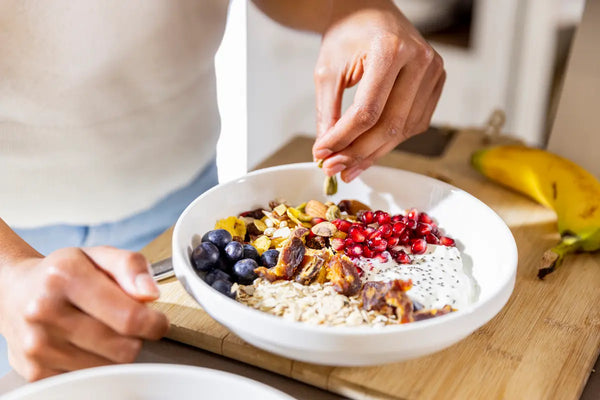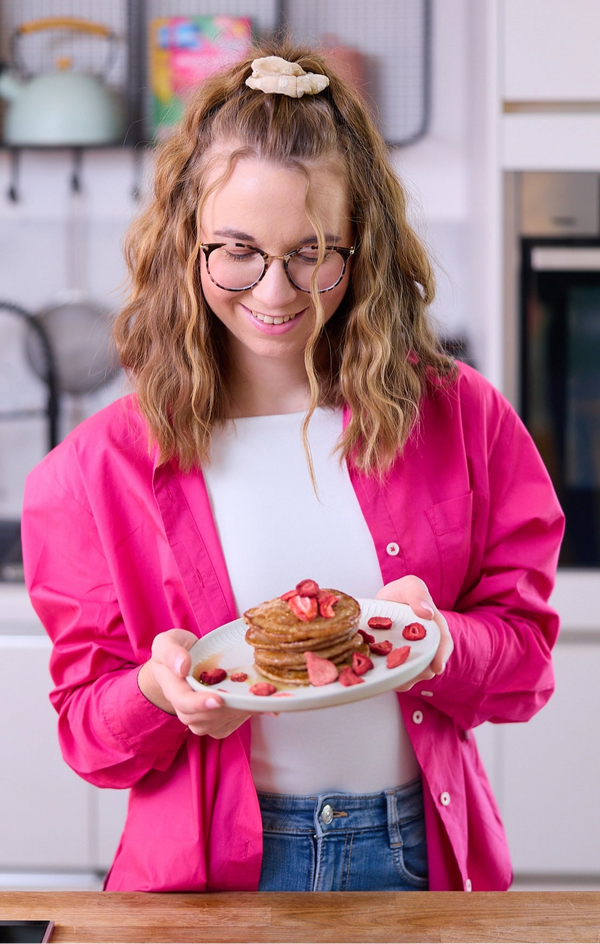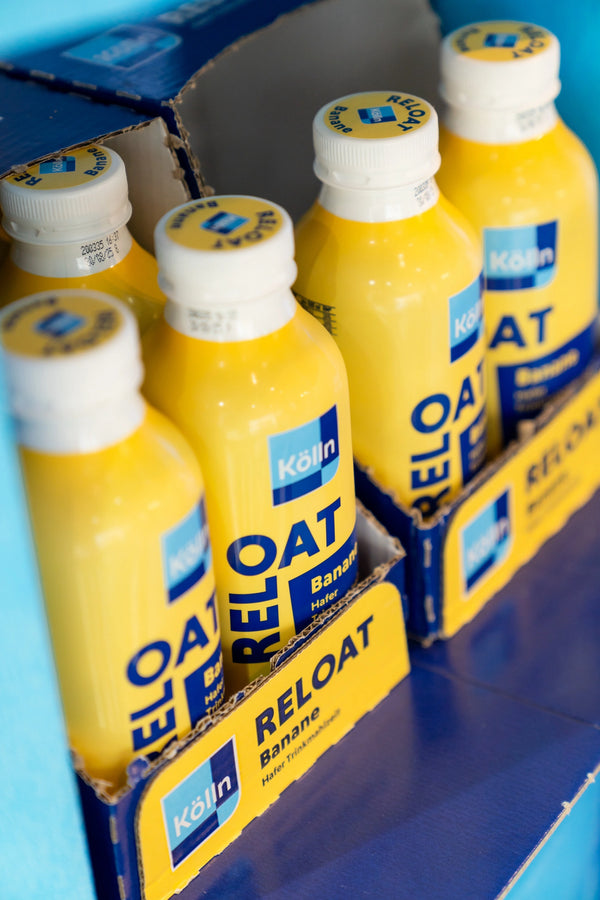Baby & toddler nutrition: The best tips for a good start
A baby brings a lot of joy – and a great responsibility: proper nutrition from the very beginning. Especially in the first year, proper nutrient supply is crucial for physical and mental development. Here you'll find answers to the most important questions about breastfeeding, starting complementary feeding, and delicious toddler-friendly meals with Kölln Schmelzflocken.
Breast milk – the best for the start
In the first four to six months, there's nothing better for your baby than breast milk! It provides all the nutrients they need in a perfect balance. If breastfeeding isn't possible, there are special infant formulas available – identified by the label "Pre" or the number "1."
When breastfeeding, mom and baby are an unbeatable team
Breastfeeding on demand strengthens the bond and ensures optimal nutrient supply. Especially in the first few weeks, this can sometimes even be at night. Tip: Breastfeed your baby on both sides at every feed and make sure you alternate between the "last" side and the first. The more often you breastfeed your baby, the more milk production is stimulated. From the 7th month, milk alone is no longer enough. Time for complementary foods! Start with small spoonfuls and gradually replace one milk feed with puree or a bottle. Sounds like a challenge? Don't worry – your baby will show you the way.
The first porridge – a gentle start to complementary feeding
Your baby is ready for their first spoonful of puree! A mild carrot puree is the ideal starter. After a few days, you can add potatoes and meat to the mix – you've got the classic vegetable-potato-meat puree. More variety increases the acceptance of new foods – so try different vegetables! In addition to carrots, broccoli, kohlrabi, zucchini, spinach, cauliflower and fennel are all well-tolerated.
This is what you need for carrot-potato-meat mash:
- 20-30 g meat (veal, beef or chicken)
- 90-100 g carrots
- 40-60 g potatoes
- 8-10 g corn germ or rapeseed oil
- A little water ensures a soft consistency
Preparation:
Cook the meat in a little water. Wash the carrots and potatoes thoroughly, peel them, chop them, and sauté them in about 100 ml of water. Then puree everything with the meat and stir in the oil – done!
Can salt be used in baby food?
Babies' kidneys aren't ready for extra salt yet, so just leave it out.
Our tip: Cooking porridge takes time? No problem! Simply prepare a larger batch and freeze it in individual portions. This way, you'll always have a healthy meal ready – stress-free!
Which fish is a valuable addition to baby food?
Fish is important – even for the little ones! You can add fish to your baby's vegetable puree once or twice a week. The following are particularly suitable:
- salmon
- pollock
- cod
- mackerel
- plaice
- trout
Vegetarian? No problem!
While meat is an important source of iron, you can also provide your baby with a vegetarian puree. A vegetable-potato cereal puree provides iron – and when combined with vitamin C from fruit or juice, it's particularly well-absorbed.
This is what you need for vegetable-potato-cereal porridge:
- 100 g vegetables
- 50 g potatoes
- 10 g Kölln Schmelzflocken
- 30 ml of vitamin C-rich juice (e.g. orange juice)
- 8 g corn germ or rapeseed oil
Here's how:
Clean and chop the vegetables and potatoes, and cook them in a little water. Add Kölln Instant Pot Flakes, juice and oil. Blend everything thoroughly – and your nutritious porridge is ready!
Half-milk melt-in-the-mouth cereal – the classic for little gourmets
One month later, it's time for the second meal of puree – and with it a true classic: half-milk puree. From the sixth month onwards, you can also prepare it with 200 ml of whole milk.
This is what you need for half-and-half milk cereal:
- 100 ml fresh or UHT milk (3.5% fat)
- 100 ml drinking water
- 6 tbsp (= 20 g) Kölln Schmelzflocken
- 2 tbsp (= 20 g) fresh pureed fruit or fruit juice
Here's how:
Combine the milk, water, and instant flakes in a saucepan rinsed with cold water. Bring to a boil over medium heat while stirring. Once cooled, add fruit or fruit juice – and you're done! Extra tip: If you're using instant milk, simply boil the instant flakes with 200 ml of water, let it cool, and then stir in the milk powder and fruit puree.
Cereal and fruit porridge – fruity power in the afternoon
After the afternoon nap, there's the next energy kick: the cereal and fruit porridge.
Ingredients for cereal fruit porridge:
- 100 g fresh fruit
- 90 ml drinking water
- 6 tbsp (= 20 g) Kölln Schmelzflocken
- 1 tsp corn germ or rapeseed oil (= 4 g)
Here's how:
Wash, peel, and chop the fruit. Bring the water and instant porridge flakes to a boil, then remove from the heat. Mix in the fruit and oil – and it's ready to serve! Tip: Vary the porridge with seasonal fruit. Apples, pears, bananas, apricots, peaches, and orange juice are particularly digestible.
Baby at risk of allergies? Here's how you can support them!
Allergies often run in families. If parents or siblings suffer from allergies, the baby is at increased risk. Breastfeeding for at least six months is the best option in this case. If an allergy has already been diagnosed, special hydrolysed formulas are necessary – a paediatrician can help with this.
Good to know: Cow's milk & allergies
Should cow's milk be introduced later? No! Studies show that early exposure to potential allergens such as cow's milk in the first year of life can promote tolerance. However, it should not be offered as a drink until the end of the first year. Important: Babies should only be given pasteurised or highly heated cow's milk – raw milk is taboo.
Tip for starting complementary feeding:
Instead of starting with a milk-cereal porridge right away, you can start with a dairy-free cereal-fruit porridge. This way, you can delay the introduction of cow's milk for a month and slowly get your child used to new foods. It's important to introduce one new food at a time and wait a few days. This way, you'll quickly notice whether your child tolerates it well. A food diary can help with this – and is a valuable source of information for your paediatrician.
Do Kölln Schmelzflocken contain gluten?
Yes, because oats are not naturally gluten-free. The reason: Oats contain avenin – a protein that, while containing less prolamin than the gluten in wheat, can still be problematic for some people. So why aren't oats automatically gluten-free? During cultivation, harvesting, storage, and processing, oats can mix with gluten-containing grains. Therefore, the law defines traditional oats as containing gluten – just like wheat, rye, barley, or spelt. Kölln Schmelzflocken therefore contain gluten and are therefore only recommended for babies from the age of 5 or 6 months.
From baby food time to family cooking – this is how it works!
By their first birthday, the puree fan turns into a little explorer! Now everything is no longer pureed, but simply mashed. A mealtime routine with three main meals and two snacks develops.
What’s on the plate?
- Bread (initially without crust)
- Pasta, rice & potatoes
- Yogurt & Quark
- Whole grain products - ground into bread
- Muesli with Kölln flakes
To start with, Kölln Organic Delicate Multigrain Flakes or Delicate Kölln Oat Flakes are suitable for muesli. Later, you can switch to Regular Rolled Kölln Oat Flakes.
Step by step more independence:
Even if not everything ends up in the mouth at first, let your child eat more by themselves. Perhaps start with a piece of fruit or small pieces of bread, and then gradually learn to eat a whole meal. The bottle also slowly gives way to the training cup – patience pays off! This makes the transition to family feeding more relaxed – and even fun!
Important to note:
- No spicy or salty foods
- No gas-producing foods (legumes, cabbage)
- No small, swallowable foods (nuts, currants)












